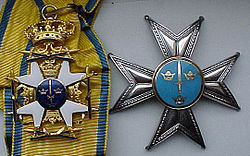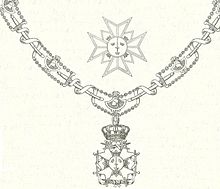- Order of the Sword
-
The Royal Order of the Sword
Kungliga Svärdsorden
Badge and star of the order Awarded by  The Monarch of Sweden
The Monarch of SwedenType Five grade order of merit Motto Pro Patria Day 28 April Eligibility Military personnel Awarded for Valour during war and service to the Armed Forces during peacetime. Status "Resting", i.e. dormant Grand Master His Majesty King Carl XVI Gustaf of Sweden Chancellor Ingemar Eliasson[1] Grades (w/ post-nominals) Commander Grand Cross (KmstkSO)
Commander 1st Class (KSO1kl)
Commander 2nd Class (KSO2kl)
Knight (RSO)
Knight 2nd Class (RSO2kl)Established 1748 - 1975 (dormant, see text) First induction 1748 Precedence Next (higher) The Royal Order of the Northern Star Next (lower) The Royal Order of Vasa 
Ribbon bar of the Order of the Sword The Order of the Sword (Officially Royal Order of the Sword Swedish Kungliga Svärdsorden) is a Swedish order of chivalry created by King Frederick I of Sweden on February 23, 1748, together with the Order of the Seraphim and the Order of the Polar Star.
Awarded to officers, and originally intended as an award for bravery and particularly long or useful service, it eventually became a more or less obligatory award for military officers after a certain number of years in service. There were originally three grades, Knight, Commander and Commander Grand Cross, but these were later multiplied by division into classes.
The motto of the order is in Latin: Pro Patria which means For Fatherland.
In 1788 king Gustav III created two new grades of the order, which could only be bestowed in war time, and those are;
- "Knight Grand Cross First Class" - The cross is in shape similar to the knights cross, but can be worn in necklet, and the star is in the shape of an upraised sword
- "Knight Grand Cross" - The cross is in shape similar to the knights cross, but can be worn in necklet, and the star is in the shape of two crossed upright swords
These grades proper were only given to commissioned officers, but an affiliated decoration, the Svärdstecken ("Badge of the Sword"), introduced in 1850, was given to non-commissioned officers; one thus decorated would call himself a svärdsman ("Sword man").
In 1952 a special medal of distinction was added to the order. These could only be bestowed in wartime. They are the War Cross of the Order of the Sword in Gold and in Silver. They come in the same ribbon as the order, and it is a medal struck in gold or silver, with an upraised sword in the center on the front.
The order is no longer awarded since 1975, but technically it still exists. His Majesty King Carl XVI Gustaf of Sweden frequently wears his Commander Grand Cross necklet and badge.
Contents
Grades
The Order of the Sword in peacetime had five classes:
- Commander Grand Cross - wears the badge on a collar (chain) or on a sash on the right shoulder, plus the star on the left chest;
- Commander 1st Class - wears the badge on a necklet, plus the star on the left chest;
- Commander - wears the badge on a necklet;
- Knight 1st Class - wears the badge on a ribbon on the left chest;
- Knight - wears the badge on a ribbon on the left chest;
plus the Badge of the Sword and the Medal of the Sword, both worn on a ribbon on the left chest.
Insignia
The collar of the Order is in gold, with nine blue enamelled swords with belts and nine "Amazon" shields.
The badge of the Order is a white enamelled Maltese Cross in saltire (i.e. "X" shaped), in silver for Knight class and in gilt for the Knight 1st Class and above; crowns appeared between the arms of the cross. The obverse central disc bore an upright sword amongst Three Crowns on a blue enamelled background; the reverse central disc had an upright sword going through a wreath, and the Latin motto "Pro Patria" (For Fatherland) on a blue enamelled background. The badge hangs from a royal crown; blue enamelled crossed swords (pointing inwards) appeared between this royal crown and the cross; for the two highest classes additional blue enamelled crossed swords (also pointing inwards) appeared on the sides and at the bottom of the cross.
The Badge of the Sword is similar to the knight's silver badge of the Order, but the cross had no white enamel.
The star of the Order is a silver Maltese Cross, the central disc bore an upright sword amongst Three Crowns on a blue enamelled background. That of Grand Cross also had golden crowns and short silver triangular rays between the arms of the cross.
The ribbon of the Order is yellow with blue stripes near its borders (i. e., the Swedish national colours).
Formerly the Order also had a distinctive blue and yellow habit worn on formal occasions such as at chapters of the Order. The habit included breeches, waistcoat, coat, cape and a black top hat with a plume of white ostrich and black egret feathers.
See also
References
- Nordisk familjebok, vol. 27 [1]
External links
- Swedish Royal Court: Orders and medals
- Image of the chain and stars of the Order of the Sword
- The Collection of Henrik Revens Website features orders and medals of Sweden as well as other Nordic countries.
References
- ^ Hovkalender 2010. Riksmarskalkämbetet (Office of the Marshal of the Realm). ISSN 0281-1456. Archived from the original on 2010-10-30. http://docs.google.com/viewer?a=v&q=cache:WDwdthdVpZwJ:www.gripsholmsslott.se/download/18.40e05eec12926f2630480004608/Hovkalendern_2010.pdf+http://www.gripsholmsslott.se/download/18.40e05eec12926f2630480004608/Hovkalendern_2010.pdf&hl=sv&gl=se&pid=bl&srcid=ADGEESixMbI-Fa1eF-ABbc4iZ-qNIoJFU_Ncd8QB0VOFioqcKyAwkEY1Fvzs5NVLocZJFiiokxwcYzEtrL45x6RaRn8hYzC_bg1OPpXTNA5o-YjP9TIkCnjAy6kEVRKdj9oclfST2pry&sig=AHIEtbRCo1nS4kAO1YBJc6BrgiT1Adjclg. Retrieved 2010-07-07.
- (Swedish) Per Nordenvall, Kungliga Serafimerorden 1748–1998. Stockholm : Kungl. Maj:ts orden, 1998. ISBN 978-91-630-6744-0
- (Swedish) Royal Court of Sweden, www.royalcourt.se
Categories:- Orders of knighthood of Sweden
- Order of the Sword
Wikimedia Foundation. 2010.


